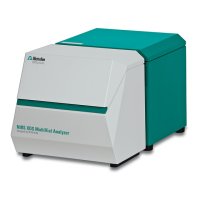
Do you have a question about the Metrohm FOSS NIRS XDS MultiVial Analyzer and is the answer not in the manual?
| Technology | Near-Infrared Spectroscopy (NIRS) |
|---|---|
| Wavelength Range | 400 - 2500 nm |
| Sample Presentation | Vials |
| Measurement Time | Seconds per sample |
| Connectivity | USB, Ethernet |
| Software | Vision software |
| Power Requirements | 100-240 V AC, 50/60 Hz |
| Sample Capacity | Multiple Vials (Automated) |
| Detector Type | InGaAs |
| Light Source | Tungsten halogen lamp |
| Sample Type | Liquids, powders, and solids |
Guidelines for operating temperature and humidity levels to ensure instrument performance.
Recommendations for minimizing dust and avoiding HVAC interference for optimal instrument operation.
Advice on installing the analyzer away from sources of vibration to prevent operational issues.
Requirements for a stable AC power source with surge protection for instrument operation.
Details on connecting the instrument via UTP crossover or network cable for data transfer.
Physical specifications of the XDS MultiVial Analyzer, including dimensions and weight.
Preferred method for instrument communication via a local area network (LAN).
Method for connecting the instrument directly to a computer without a network.
Key aspects of XDS instrument communication, including security and access protocols.
Visual representation of the XDS instrument's communication protocol and IP address assignment process.
Steps to establish communication between the Vision software and the XDS instrument.
Guidance for resolving common issues encountered when connecting the instrument to the Vision software.
Overview of the MultiVial Analyzer's design for automated vial sampling and routine analysis.
Instructions for configuring custom vial sizes within the Vision software for specific sample trays.
How to adjust the illumination beam spot size for optimal analysis of small samples.
Usage and installation of the Iris Adapter for scanning stationary objects.
Operation of the automated sample transport mechanism for moving sample cells within the module.
Steps to launch and log into the Vision software for instrument operation and data acquisition.
Setting up sample parameters and managing vial sequencing within the Vision software.
Initial diagnostic steps required in Vision software before using the instrument for analysis.
Procedures for verifying instrument performance and operation using various diagnostic tests.
General information on instrument maintenance, emphasizing the sealed optical enclosure and user-serviceable parts.
Step-by-step guide for inspecting and replacing the instrument's fan filter.
Procedure for safely replacing the instrument's lamp, including cooling time and part number.
Instructions for replacing fuses, emphasizing investigation of the underlying electrical fault first.
How to access and use the Maintenance Log in the Diagnostic Database to track activities.
Tools and documents for validating the instrument's hardware components and accessories.
Tools and documentation for validating the Vision Spectral Analysis Software.
How Vision software meets regulatory requirements for electronic records and signatures.
Steps to diagnose and resolve issues where the instrument fails to power on.
Troubleshooting steps for establishing communication between Vision software and the instrument.
Diagnosing and resolving issues related to the instrument lamp not functioning.
Steps to troubleshoot failures in the instrument's Wavelength Linearization process.
Diagnosing and resolving issues when the instrument fails the Performance Test.
Troubleshooting steps for instrument calibration failures, including standard positioning.
Identifying potential issues when the instrument's gain readings are excessively high.
Diagnosing why instrument cooling fans are operating at maximum speed.
Addressing X-Y positioning errors in Vision, often related to lid open or mechanism issues.
Troubleshooting when the sampling mechanism fails to move with a large sample cell.
Resolving issues where the X-Y mechanism does not move correctly with a vial tray.
Troubleshooting X-Y mechanism errors caused by interaction with the Iris Adapter.
Diagnosing why the instrument's cooling fans are not operating.
Procedure for setting the sample carriage to the shipping position and installing protective foam.